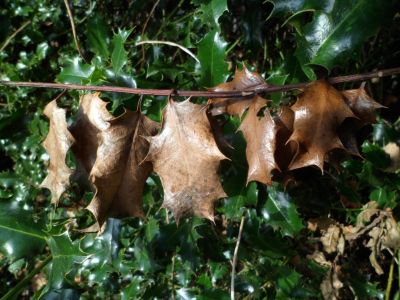Common Pests and Diseases Damaging Holly Bushes
For the most part, hollies are extremely hardy, suffering from few pests or diseases. In fact, most problems that do occur are usually associated with other factors, such as environmental conditions. However, pests and diseases damaging holly bushes can happen so it’s important to become familiar with the most common ones for help in prevention as well as treatment.
Holly Tree Pests
Holly tree pests such as scale, mites, and holly leaf miner are the most commonly seen affecting hollies.
Scale – While light infestations of scale can usually be controlled by hand, scale control for heavier infestations generally requires the use of horticultural oil. This is usually applied prior to new growth to kill both adults and their eggs. Mites – Spider mites are common causes of discoloration and speckling of holly foliage. While introducing natural predators, such as ladybugs into the landscape can help minimize their numbers, a nice healthy dose of soapy water or insecticidal soap sprayed regularly on plants can also help keep these pests at bay. Leaf Miner – The holly leaf miner can cause unsightly yellow to brown trails throughout the center of leaves. Infested foliage should be destroyed and treatment with a foliar insecticide is often required for leaf miner control.
Holly Tree Disease
Most diseases of holly can be attributed to fungus. The two most prevalent fungal holly tree diseases are tar spot and cankers.
Tar Spot – Tar spot usually occurs with moist, cool springtime temperatures. This disease begins as small, yellow spots on the leaves, which eventually become reddish brown to black in color and drop out, leaving holes in the foliage. Always remove and destroy infected foliage. Canker – Cankers, another holly tree disease, produce sunken areas on the stems, which eventually die out. Pruning out infected branches is usually necessary in order to save the plant.
Improving air circulation and keeping debris picked up is good for prevention in both cases.
Environmental Diseases of Holly
Sometimes a holly bush disease is due to environmental factors. Such is the case for problems like purple blotch, spine spot, holly scorch, and chlorosis.
Purple Blotch – With purple blotch, leaves of holly become splotched with purple-looking spots, which are usually brought on by drought, plant injury, or nutritional deficiencies. Spine Spot – Spine spot is similar with gray spots edged with purple. This is most often caused by leaf punctures from other leaves. Scorch – Sometimes rapid temperature fluctuations in late winter can lead to browning of the leaves, or holly scorch. It is often helpful to provide shade to plants most susceptible. Chlorosis – Iron deficiency can lead to the holly bush disease, chlorosis. Symptoms include pale green to yellow leaves with dark green veins. Reducing pH levels in soil or treating it with a supplemental iron-fortified fertilizer can usually alleviate the issue.
